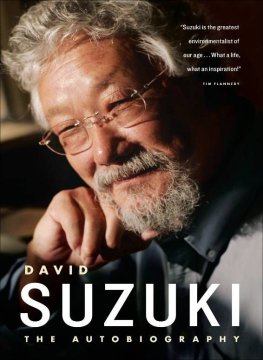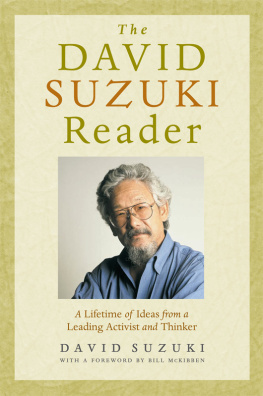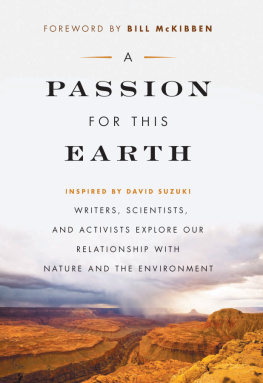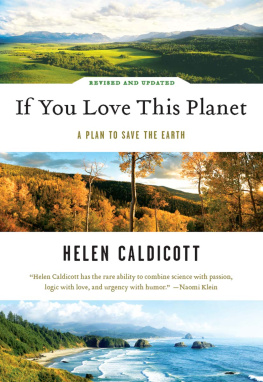THE SACRED BALANCE
THE
SACRED BALANCE
REDISCOVERING
OUR PLACE IN NATURE
DAVID
with AMANDA MCCONNELL & ADRIENNE MASON
SUZUKI
UPDATED
& EXPANDED

Copyright 1997, 2002, 2007 by David Suzuki
07 08 09 10 11 5 4 3 2 1
All rights reserved. No part of this book may be reproduced, stored in a retrieval system or transmitted, in any form or by any means, without the prior written consent of the publisher or a licence from The Canadian Copyright Licensing Agency (Access Copyright). For a copyright licence, visit www.accesscopyright.ca or call toll free to 1-800-893-5777.
Greystone Books
A division of Douglas & McIntyre Ltd.
2323 Quebec Street, Suite 201
Vancouver, British Columbia Canada V5T 4S7
www.greystonebooks.com
The David Suzuki Foundation
2192211 West 4th Avenue
Vancouver, British Columbia Canada V6K 4S2
Library and Archives Canada Cataloguing in Publication
Suzuki, David, 1936
The sacred balance: rediscovering our place in nature, updated & expanded/
David Suzuki; with Amanda McConnell & Adrienne Mason.3rd. ed.
Includes bibliographical references and index.
ISBN 978-1-55365-166-6
1. Human ecology. 2. Social ecology.
I. Mason, Adrienne II. McConnell, Amanda III. Title.
GF80.S89 2007 304.2 C2007-904391-7
Editing by Nancy Flight Cover and interior design by Jessica Sulivan Cover photograph by Sanford/Agliolo/CORBIS Illustrations on pages 56, 58, 85, 135, 139, 141 and 188 by Vicky Earle Printed and bound in Canada by Friesens Printed on acid-free paper that is forest friendly (100% post-consumer recycled paper) and has been processed chlorine free. Distributed in the U.S. by Publishers Group West
Every attempt has been made to trace accurate ownership of copyrighted material in this book. Errors and omissions will be corrected in subsequent editions, provided that notification is sent to the publisher.
We gratefully acknowledge the financial support of the Canada Council for the Arts, the British Columbia Arts Council, the Province of British Columbia through the Book Publishing Tax Credit, and the Government of Canada through the Book Publishing Industry Development Program (BPIDP) for our publishing activities.
This book is dedicated with love to Kaoru and Setsu, my parents, who taught me to love nature and to respect my elders; Tamiko, Troy, Laura, Severn and Sarika, my children, who lifted my sight into the future; and Tara, my wife, partner and best friend, who showed me the meaning of love and commitment.
INTRODUCTION
TO THE REVISED EDITION
WHEN THIS BOOK was published a decade ago, my goal was to persuade people to acknowledge the real bottom line of human needs. A decade earlier, in 1988, people around the world had identified the environment as their greatest concern. In the United States, in response to that concern, George H.W. Bush promised to be an environmental president if elected. Unfortunately, once he took office, he promptly demonstrated how shallow campaign promises can be.
The same year, British prime minister Margaret Thatcher declared on television that she was a greenie, while newly elected Canadian prime minister Brian Mulroney demonstrated his concern for the environment by appointing his brightest star, Lucien Bouchard, minister of the environment. I was preparing for Its a Matter of Survival, a five-part series for CBC Radio, and interviewed Bouchard shortly after his appointment. When I asked him what was the most critical environmental problem Canada faced, he immediately answered, Global warming.
How serious is it? I asked.
His answer was, It threatens the survival of our species, and he called for serious efforts to reduce greenhouse gas emissions.
Also in 1988, Mulroney asked a highly respected politician, Stephen Lewis, to chair a session of a conference on the atmosphere held in Toronto. The climatologists were so alarmed by global warming that they issued a press release at the end of the conference declaring that global warming represented a threat to human survival second only to nuclear war and called for a 20 per cent reduction in greenhouse gas emissions below 1988 levels in fifteen years.
So, public concern was high, the minister of the environment declared global warming a threat to the very survival of our species and scientists called for action, with a specific target for reducing greenhouse gas emissions. Had we taken those warnings seriously and acted to achieve that target, we would now be well beyond the Kyoto targets (5 to 6 per cent below 1990 levels by 2012), and the problem of climate change would be much less difficult and complex. But we did not heed the warnings.
Shortly afterwards, even though the Worldwatch Institute had designated the 1990s the Turnaround Decade, a ten-year interval in which humanity had to deviate from its destructive course onto a sustainable path, the environment dropped out of sight in the polls. Instead, the media turned their attention to the explosive rise of the Dow Jones average from below 2000 to above 10,000, the collapse of the dot-com bubble, corporate scandals from Enron to WorldCom and Tyco, and the Y2K crisis.
Almost two decades later, concern about the environment is once again rising. For years, I had talked of crossing Canada in a bus to engage the public in conversation, drawing my inspiration from the famous Chautauqua Forum in the United States early in the twentieth century. In 2006, staff at the David Suzuki Foundation took me up on the idea, as polls revealed that the environment had risen to second place in the Canadian publics priorities, behind only health. Because of Hurricane Katrina in the United States and a prolonged drought in Australia, Americans and Australians were also becoming more aware of and concerned about climate change. To me, health and the environment are inseparably linked; we cant be healthy without a healthy planet. So we decided to cross Canada in a bus to share ideas with and listen to the public. We asked Canadians to tell us what they would do for the environment if they were prime minister.
For years, the media had been reporting events like killer storms, destructive fires, massive floods, pine beetle epidemics, and so on, which corroborated the predictions by climatologists and increased the publics sense that something was wrong. Former vice-president Al Gores An Inconvenient Truth was like a seed crystal dropped into a supersaturated solution, precipitating public awareness and concern about global warming.
By the time my bus tour started on February 1, 2007, in St. Johns, Newfoundland, climate and the environment had rocketed to the top of public priorities in Canada. In Australia, Prime Minister John Howard was forced to acknowledge the reality of climate change, while in the United States, California governor Arnold Schwarzenegger became the unlikely poster child for the environmental movement because of his action to reduce greenhouse gas emissions. When I reached Victoria, British Columbia, on February 28 and then flew to Ottawa two days later, I had spoken with more than thirty thousand people, and more than six hundred had been videotaped stating what they would do for the environment if they were prime minister. It was clear that, once again, people wanted action on major environmental issues and were willing to make the sacrifices needed for a more secure future.
Today the evidence that climate change has kicked in is overwhelming, but the challenge of reducing emissions is much more difficult and more expensive than it was one or two decades ago because of our failure to cap emissions and begin reductions. Yet even now, despite that evidence, opposition to beginning major reductions continues, driven primarily by ominous predictions of the costs, loss of jobs and economic destruction. More than ever, we need agreement about what humankinds real bottom line is, and achieving that agreement remains the primary goal of this book.
Next page









